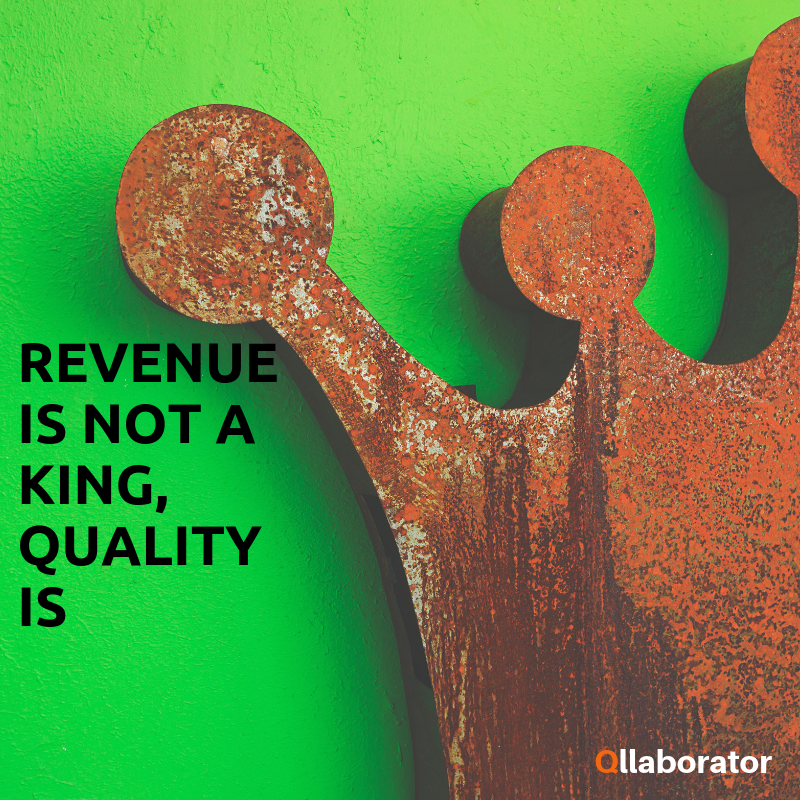
Revenue is not a King. Quality is a King
Don’t get me wrong here. Maximizing profit is the ultimate goal for every company and revenue itself is the main indicator of company success. Bottom line in business will always be $, €, or whatever other currency you are using. The problem starts when management doesn’t recognize quality as a key revenue driver. A short-sight approach that affects organizational culture and has a strong correlation with positioning and sizing of the quality team. This approach is tricky, as it can result in improvement for the short-term, but likely to have a dramatic impact for the long-term. When the entire organization is focused on revenue and revenue only, shortcuts will be made to enable results. Eventually, rounding corners of basic quality requirements like design reviews, FMEAs, and lesson learned will heavily compromise customer satisfaction. Unhappy customers are known to vote with their feet, returning the product or stop buying it. Either way, revenue will go down with a real risk of losing market share. The relationship between quality and money cannot be more clear than that. The question is, how to influence management to make quality a priority? Here are few ideas.
Learn from failures – of others.
Quality failures can have such a destructive impact on sales and brand loyalty. It takes only a few failures to damage brand credibility and lose years of reputation. Everybody knows it, of course, but nobody thinks it will happen to them – until it does. The challenge here is to enforce management to think and plan alike. An effective way to do it is reviewing the top quality failures in the relevant industry, and map similar gaps in your organization.
For illustration, let’s review the NASA Shuttle Challenger explosion in 1986. According to Wikipedia, an O-ring failed at liftoff. This O-ring was not designed to fly under unusually cold conditions as in this launch. Furthermore, it was found that NASA’s organizational culture and decision-making processes had been key contributing factors to the accident.
Apparently, NASA managers had known about a potentially catastrophic flaw in the O-rings. But, they failed to address this problem suitably. It will be an eye-opener to review a similar case together with your management team to see they take on it.
-Do you have the right organizational culture and mindset?
-Is decision-making process clear?
-To what extent company exposed to catastrophic failures?
-Are you managing your risks properly? Can you quantify your risks?
From here, the road to a strategic quality plan that will leverage the attention to quality is short.
Measure Quality Impact, not symptoms
The challenge is to measure quality in a way that truly reflects the impact on business. A popular example is ‘customer complaints’ indicator. Commonly, it refers to the number of complaints by a certain period. Rare to find a quality manager that measure the effect on customer success. But, this is the one indicator truly matters. If your customers fail to meet their goals due to a quality failure – then the number of complaints does not really matter. Even one case can severely affect customer satisfaction. Hence no. of complaints is no longer a relevant indicator in today business environment. The same goes for other quality indicators, like suppliers’ quality, MRB, no. of risks in production floor and so on. Going forward, you should define a metric to measure the impact, not the occurrences.
Measure Quality in Dollars (chiching!)
The idea is to talk with management in their language. Create a meaningful quality metric to help them understand that every dollar invested in quality will increase company bottom line – several times. Create a useful quality metric to help them know that every dollar spent in quality will improve company bottom line – several times. It will require rephrasing your current indicators and add Cost of Poor Quality (COPQ) if you are not doing so already. These are are costs that would disappear if systems, processes, and products were perfect. Typically, COPQ includes material and labor costs associated with a faulty product. The ideal COPQ also measures the value of lost opportunities – but these are often more challenge to measure.
Quality is important. Nevertheless, a significant responsibility in your role is influencing senior management to assign a higher priority to quality and invest the required resources for this purpose. One of the effective ways to do it is correlating quality with business success and dollars bottom line. This is probably the right path to build and maintain a fully functioning quality management system.


No Comments